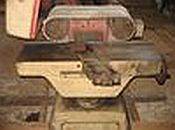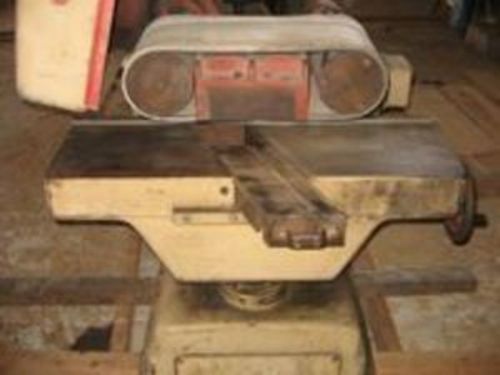An Antique Wood Scraper
Woodworkers puzzle over an old piece of shop iron and share some old-time lore. September 28, 2006
Question
Can any one tell me if this machine is a wood scraper or a planer? I was told that it is a wood scraper and is made in Japan. If it is a wood scraper , how is the blade sharpened? Just like the planer?

Forum Responses
(Solid Wood Machining Forum)
From contributor A:
How about a bigger picture - I can't quite make it out in this one.
From contributor B:
Years ago Hitachi and Makita tried marketing a machine called a fixed knife surfacer. It is not a scraper at all. Today Marunaka sells them as veneer slicers. I can't make out your photo either but I bet it's a single blade surfacer. Incidentally there was a machine called a scraper which was basically a plane with a fixed scraper knife. I have only seen it in the old trade school textbooks.
From contributor B:
It looks like a small conveyor with a small belt sander on top. Maybe thatís what he meant by a wood "scraper"
From the original questioner:
I hope this image is clear enough. The blade holder in the picture has been pulled out partially to show where it is located and how it looks. The blade has a capping on the flat side like an old handplane style. The seller says that using this he does not have to use a sander to smooth the wood pieces. The shavings look like shavings for a handplane. As I am making small wooden products at the moment, I was thinking that by getting this I will not have to get a widebelt sander until I graduated to making larger products. Currently I am using a hand held belt sander to do the sanding.

Click here for full size image
From contributor A:
That is one rough looking feeding mechanism if you ask me. Clearly, it was once a planing device, which I have heard are popular in some parts of the world, but this looks like it needs some serious TLC. On these machines, its all about the blade, so if that is in good shape the rest should be fixable, but you may end up mounting a feeder on the thing to get material across it.
From contributor D:
Besides the fact that I have no idea what it is, my first thought about this machine was, if it is a useful tool, why don't most of us here at WOODWEB know what it is? If it had real value as a durable, functional machine, most of us would know what it was and how it works and a few of us would have an operating one in our shops. As a result I venture to say, stay away from it! I'm afraid you may waste a lot of time trying to make it work for you and end up no closer to the solution youíre looking for.
From contributor E:
I am 77 years old and have been in the business since 1949, representing the Baxter D. Whitney Machine Co., and later Newman-Whitney from that date until 2002. The wood scraper was long before my time. I have never seen one although I do have old Whitney catalogs that show them. My Dad was familiar with them and when the Japanese showed a scraper in the machinery shows in the early 1960's, Dad laughed. I remember very little of his comments other than he said that no one in the furniture industry had the skills to operate one. So I know nothing about them other than my Dad knew more about planers and their history than anyone in the business. That one comment was enough for me. This is an idea out of the dark ages of woodworking. It might be OK for the machine crank that will make something run just for the fun of it.
From the original questioner:
Thank you for your responses. I don't think I will buy this machine after reading all your useful comments.
From contributor F:
All I can tell you is that Fine Woodworking had some laudatory articles back in the 70s about this type of machines as made in Japan, supposedly for low volume production of a fine scraped finish. Check their archives for more info.
From the original questioner:
To contributor F: It looks like what you have said is right. I have been tinkering with the machine and after trial and error I manage to set the knife correctly. I am able to scrape a few pieces of wood today and the wood shaving is just like that of a hand scraper/smoothing plane. It comes out in thin shavings. Next I will try to find out how useful it will be for me in my work as I make small runs only.
From contributor G:
After hearing it works it sounds like a simple tool. Scraping wood with other then a card scraper is tricky so if you can get it set up it may save some time. Scraping is sure faster then sanding, and it should also leave a nicer finish.
From John Van Brussel, technical advisor, Veneer Forum:
The machine you have is commonly called a super surfacer. It is used in shoji and musical instrument manufacturing and any other manufacturing where a super fine finish is required. It is usually a pair of knives set in a turntable. The grinding of the knives is quite complex. The shavings produced when set up properly should be like and onion skin. The one you have pictured appears to have a removable knife cassette system. Usually there is a hood over the rubber feed belt.
From the original questioner:
To John Van Brussel: You are right. The wood shavings come out in thin strips when the knife is properly set. I have tried it. You are also right that there is a hood covering the rubber belting. In fact a bit of the hood is seen on the top left of the picture which shows the machine with the hood open to expose the belt.